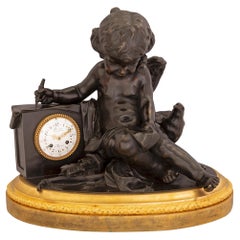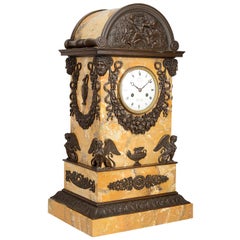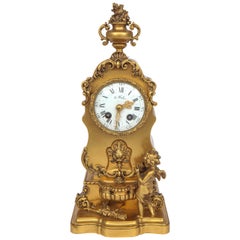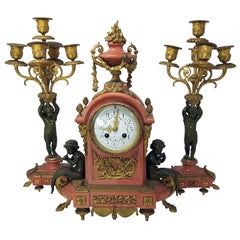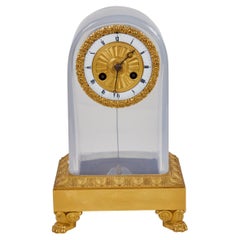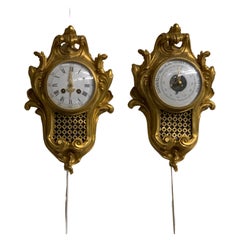Bronze Clocks
to
184
1,566
11
117
1,252
197
11
107
48
17
32
4
15
16
3
5
8
7
1
1
241
190
122
86
50
36
18
14
14
13
11
5
4
3
2
1
4,042
1,623
1,577
1,039
1,005
821
620
1,447
1,282
40
39
37
Height
to
Width
to
1,577
1,566
1,566
25
20
12
12
11
Material: Bronze
French Louis XVI Style Ormolu and Patinated Bronze Clock, Signed by Deniere
Located in West Palm Beach, FL
A charming and extremely high quality French 19th century Louis XVI st. ormolu and patinated bronze clock, signed Denière. The clock is raised by a fine oval shaped ormolu base with a richly chased wrap around berried laurel band and mottled border. The adorable and wonderfully detailed patinated bronze winged cherub is seated with his bow and arrows in a quiver at his side draped in a lovely flowing fabric. He is attentively holding a scroll in his left hand, seemingly reading and taking notes with a pen in his right hand while leaning on the clock with a curious raven at his side. The clock is set in a patinated bronze box...
Category
19th Century French Louis XVI Antique Bronze Clocks
Materials
Bronze, Ormolu
19th Century Grand Tour Influenced Mantel Clock
Located in Brighton, Sussex
A very impressive 19th century French Sienna marble and bronze mounted Grand Tour influenced mantel clock, having an arched top, mythical gods...
Category
Late 19th Century French Grand Tour Antique Bronze Clocks
Materials
Siena Marble, Bronze
Late 19th Century French Doré Bronze Clock
Located in Los Angeles, CA
Late 19th century French finely chased doré bronze clock with cherub and fountain motif.
Category
Late 19th Century French Antique Bronze Clocks
Materials
Bronze
19th Century French Provincial Three-Piece Clock Set
Located in London, GB
A fine quality three-piece French gilt red marble and bronze clock set comprising
two three branch candelabra and a mantel clock.
The clock has a whi...
Category
19th Century French French Provincial Antique Bronze Clocks
Materials
Marble, Bronze
19th Century Desk Clock
Located in Los Angeles, CA
A chic, c. 1825 French, looping desk clock with a central timepiece framed in foliate embellished, bronze doré wreath. The clock set into a pale blue, Opalin...
Category
1820s French Antique Bronze Clocks
Materials
Metal, Bronze
Pair of Cartel and Barometer in Bronze Style Louis XV
Located in Los Angeles, CA
A very fine pair of bronze cartel and barometer in louis XV style
the both case is exuberantly embellishedwith scrolling work of the louis XV style,the both faces are in enamel.
Category
Early 1900s Louis XV Antique Bronze Clocks
Materials
Bronze
19th Century Bronze and Champleve Enamel Clock Set
By Neo Craft
Located in London, GB
French late 19th century clock set, consisting of a clock and a pair of matching candelabras.
Category
Late 19th Century French Louis XVI Antique Bronze Clocks
Materials
Bronze
19th Century French Champlevé Enamel and Marble Clock Set
By Napoléon III
Located in London, GB
Three-piece marble and bronze Champlevé enamel clock garniture set, comprising of a central clock and a pair of candelabra. The clock is set on a white marble base on a rectangular p...
Category
Late 19th Century French Other Antique Bronze Clocks
Materials
Bronze
Impressive Antique Austrian Champlevé Enamel, Silver-Gilt and Lapis Lazuli Clock
Located in London, GB
Impressive antique Austrian champlevé enamel, silver-gilt and lapis lazuli clock set
Austrian, Late 19th century
Clock: Height 91cm, width 37cm, depth 37cm
Candelabra: Height 64cm, width 24cm, depth 24cm
Clock case: Height 97cm, width 44cm, depth 41cm
Candelabra case: 67cm, width 27cm, depth 27cm
Crafted in Austria in the late 19th century, this magnificent three-piece clock set was most likely gifted to the Imperial Russian family by the Austro-Hungarian Royal family. Its design is inspired by various cultures and styles, whilst its high quality celebrates some of the best craftsmen of the late 19th century.
Of a tiered pagoda shape, the clock is surmounted by an eagle, its wings spread wide landing atop a vibrant lapis lazuli ball. The eagle is most likely a reference to Turul, a mythological animal which is a symbol of Hungary. This bird of prey is also a popular feature within Turkish traditions.
Within a canopy, supported on four sturdy lapis lazuli pillars two prominent silver-gilt bells are hanging. These are carved with various motifs such as acanthus leaf design and connect to the clock mechanism below. The bells ring informing its users of the time.
All four sides of the piece are inset with a clock, an unusual feature on an object of this type and a testament to its highest quality. The inclusion of clocks on all sides signifies that the antique is aimed to be a centrepiece, admired from all sides. The dial is decorated using the champlevé enamelling technique, whereby ‘parcels’ are carved into the silver gilt and into which enamel is poured. The 12 numbers are coloured in black with a gold outline and are surrounded by a white circular background making them stand out and easy to read. The hour clock dial is cast in the form of a sun, while the minute hand is represented as the moon. The two motifs symbolise one’s bright and gloomy sides of existence.
The four corners around the clocks are mounted with three-dimensional female figures dressed in traditional garments from around the world. For example, one figure is dressed in typical Turkish clothing...
Category
Late 19th Century Austrian Antique Bronze Clocks
Materials
Lapis Lazuli, Silver, Bronze, Enamel
Palatial & Rare Napoleon III French Ormolu and Patinated Bronze Clock, Detouche
By C. Detouche
Located in New York, NY
A Palatial and Extremely Rare Napoleon III French Ormolu and Patinated Bronze Regulateur de Parquet Clock by Louis-Constantin Detouche, Paris, Circa 1850
An exceptional testament to the grandeur and technical mastery of 19th-century French horology, this palatial and extraordinarily rare Napoleon III ormolu and patinated bronze Regulateur de Parquet clock stands as a crowning achievement of the renowned Parisian horologist Louis-Constantin Detouche. Created circa 1850, this monumental timepiece exemplifies the perfect synthesis of artistic opulence and mechanical precision, distinguishing itself as one of the most impressive works from Detouche’s illustrious oeuvre.
At over six feet tall, this clock’s imposing scale and decorative grandeur make it an object of immense historical and aesthetic significance. The case, crafted from the finest French ormolu, features two majestic patinated bronze seated putti, serving as allegorical figures and underscoring the artistic sophistication characteristic of the Second Empire style. The white enamel dial, elegantly signed "C. Detouche/Paris," affirms its prestigious maker, while the movement, meticulously numbered 7064 and bearing the stamps "C. Detouche RUE St. MARTIN" and "C. DETOUCHE 158 R. St MARTIN 160," speaks to the highest standards of 19th-century horological craftsmanship. Further distinguishing this piece is the medaille d’argent stamp, a testament to the numerous accolades and awards bestowed upon Detouche for his innovations in timekeeping.
A Masterpiece of Horological Artistry:
Louis-Constantin Detouche was not merely a clockmaker; he was a visionary whose contributions to horology redefined precision and complexity. This particular regulator clock...
Category
19th Century French Napoleon III Antique Bronze Clocks
Materials
Bronze, Ormolu
Important Cercles Tournants Rotary Clock set by Deniere
Located in Los Angeles, CA
Very Large Important and Rare Napoleon III Period Ormolu And Patinated Bronze Sculptural rotary 3-piece clock set ("Pendule A Cercles Tournants") compr...
Category
19th Century French Napoleon III Antique Bronze Clocks
Materials
Bronze
